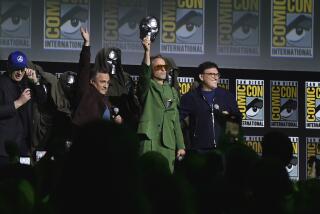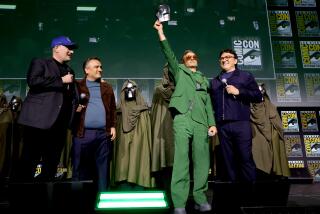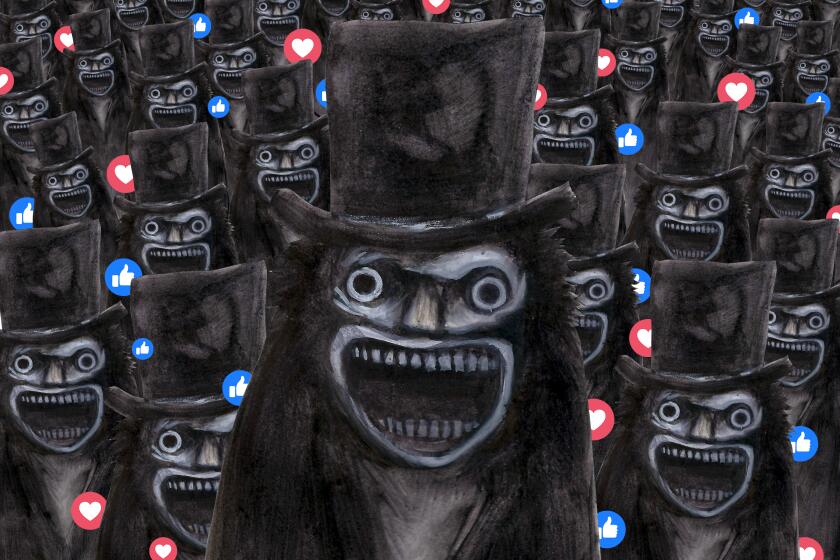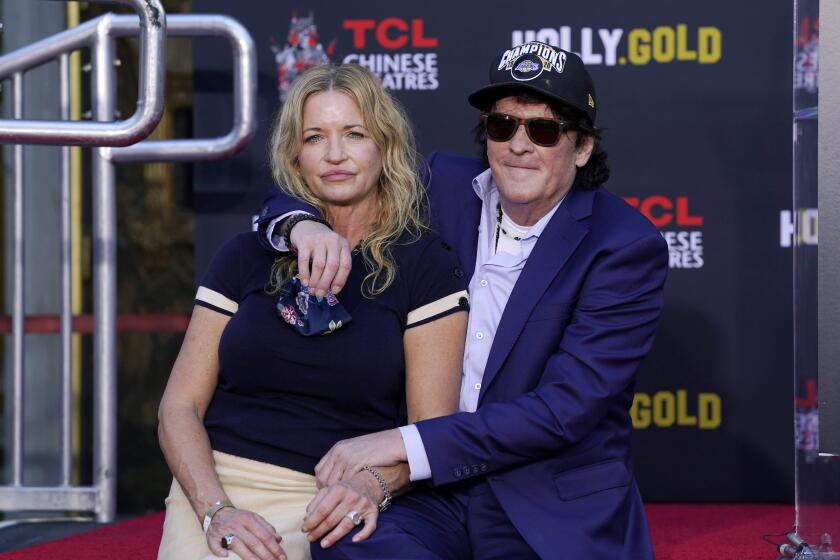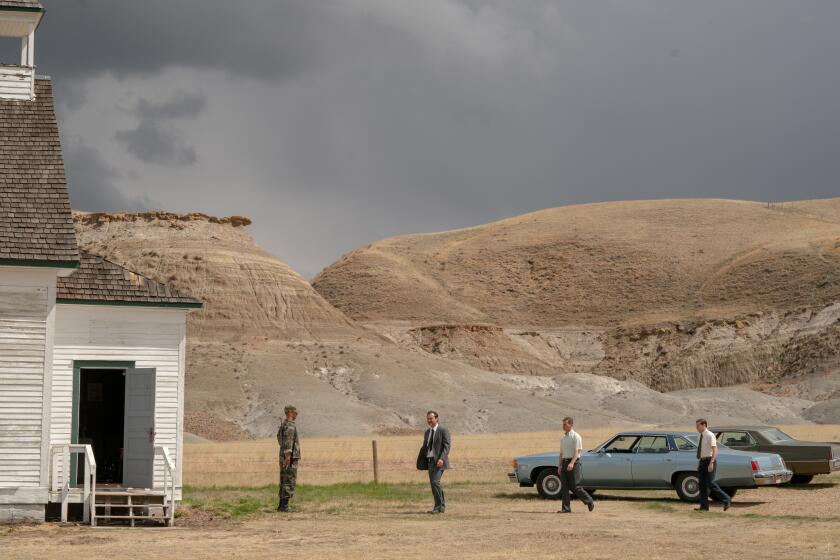‘Avengers: Endgame’ writers on Thor-Lebowski, Black Widow and reviving ‘Agent Carter’
When screenwriters Christopher Markus and Stephen McFeely were hired to write both “Avengers: Infinity War” and “Avengers: Endgame” back in 2015, they were basically given free rein to conclude the most successful superhero blockbuster franchise in cinematic history.
“[Disney] basically said, ‘We want to bring the MCU to the close of a definitive chapter,’ ” recalled Markus. “ ‘We want to do two movies [that are] very different in tone, you can draw from anything, [but] Thanos [has to be] in it.’ ”
No strangers to Marvel, the longtime collaborators and friends had previously written all three Captain America movies, “Thor: The Dark World” (with Christopher L. Yost) and created the TV series “Agent Carter.”
But bringing three phases’, 11 years’ and 22 films’ worth of storytelling to a close required a 60-page document mapping out all of the possible ways the saga could conclude. “We asked people to basically circle things and start narrowing our options down,” Markus said.
[Warning for those who haven’t yet seen “Avengers: Endgame”: There are spoilers ahead.]
The resultant film is a three-hour-long epic that interweaves and wraps up multiple character arcs while revisiting several of the early films that have contributed to the framework of the MCU, including the oft-ridiculed “The Dark World.”
The Times caught up with Markus and McFeely to chat about Thor’s grief weight, Captain America’s happy ending and the source of that “America’s ass” joke.
FULL COVERAGE: ‘Avengers: Endgame’ »
Thor has obviously been a part of the Avengers since the beginning, but he’s still kind of a breakout in “Endgame.” What was the trick to making him funny but still one of Earth’s mightiest heroes?
Markus: He got re-toned by [director] Taika Waititi, [writer] Eric Pearson and Chris Hemsworth in “Thor: Ragnarok,” and that was a gift to us. But we also wanted to give him real obstacles and real consequences. All the things he lost in that movie, he takes it with such aplomb, but he’s really lost everything. Basically from his first movie, he is headed for the throne. He has all this burden of purpose on him. And so his arc in all these movies is learning to let go of what people expect of him and embrace what he himself feels he is.
It turns out Hemsworth is a really good actor. He’s not just gorgeous, he’s funny. It’s [been] such a great second half of the MCU for him. I’m really, really happy that that all came about.
Where did the Lebowski visual references come from?
Markus: We knew we wanted him to kind of get a little schlubby and be hanging around the house. And Lebowski is sort of the world’s primary reference for a guy in a bathrobe. So we gave our ideas about it to the costume and art department and they came back with Thor in a bathrobe with sunglasses and suddenly it all clicked.
Was there a temptation to have him get back in shape before the battle?
McFeely: It came up but we were really adamant about not doing that because I think that would treat it more like a joke. And the idea is that this is who he is now and he’s still a hero. And when he calls down the lightning and gets both hammers, all it does is put a suit on him and twist his beard into a braid, it doesn’t magically take 200 pounds off.
Markus: And I think what his mother tells him, “Don’t be who you’re supposed to be, be the best version of who you are,” includes that. We didn’t want to treat the weight gain like the issue that he needed to get over. Like “Thor got fat and now he needs to go on a diet.” No, he needs to feel OK about himself no matter who he is.
Where did that beard braid come from?
McFeely: I don’t know about the braid exactly. [When he gets the hammer in the first “Thor”] he’s finally worthy and it sort of transforms him into, it puts the armor on him. And we knew that’s how the hammer works. It sort of jazzes you up. But I guess I don’t know where the braid came from. Hair and makeup, costume? … We’re not sure.
“Thor: The Dark World” has gotten a lot of flack over the years. Was it important for you to address that in this movie?
McFeely: No, it wasn’t important to address it, it’s just where one of the stones was. That second act [of “Endgame”] is going back into the other movies and finding the stones. Other than a brief moment where it would’ve been with Benicio del Toro at his Collector’s Museum, it was in Asgard during the movie. And we’d already seen Benicio del Toro in [“Infinity War”].
Markus: We knew we wanted each journey that the heroes took to not just be a stone journey, but also to provide some emotional resolution. Thor’s turmoil was really [eased] by getting together with his mom. And that was a very poignant moment because she dies later that day, so we could both get the stone and seek the resolution that we needed for him.
Do you take issue with fans’ complaints about that film?
Markus: I think the bar is set high for Marvel. We share a credit on that movie, we came in to help out, so it’s on our résumé. Listen, there are 22 movies. One’s going to be first and one’s going to be last. I think there’s plenty of delightful things in it.
I understand Iron Man’s death was decided early on. How was it decided just exactly how he would die?
Markus: We always knew we wanted him to bring it on himself as opposed to being killed by Thanos. Because it’s really the one thing left for him to do, in a way. The five-year jump allowed him to become this fully realized human: He married Pepper, he had a child, he basically retired from public life and lived a very peaceful existence out there in the country.
We knew he was going to die but we wanted to put it in his hands as opposed to someone else’s. We didn’t always know that the Infinity Stones were going to be what caused it, but once we worked out the mechanics of it with the nano particle suit that both the gauntlet and his suit were made out of, it all worked too perfectly not to do.
What are your thoughts on the mixed fan reaction to Black Widow’s death?
Markus: I understand she was a beloved character and none of us want our heroes to die. But that is the natural end of her journey and it is the sort of apotheosis of who she is becoming. She started out as a very dark character. Even before the movies begin, she’s a spy, she’s an assassin. She has red in her ledger and to take her all the way to that sacrifice point is where her character is headed. And to not let her do that seemed a disservice to her as a hero.
McFeely: Right. We couldn’t be afraid to kill her simply because she was the most important and the first female character. Again, the goal with all these things is just to put these people on a journey or continue or end their journeys. Steve Rogers goes from selfless to slightly more self-interested. Tony goes from selfish to giving himself for the universe. Thor goes from obligated to letting go of that obligation. And Black Widow goes from a woman with red on her ledger to clearly wiping out all that red.
What are some scenes that didn’t make the final film or deleted scenes that you felt should’ve been included?
Markus: You never know what’s actually going to make it out into the world. We did have a scene illustrating more actively what the Hulk had been up to in terms of being a hero, as opposed to just starting it in the diner and explaining things. But it didn’t give you anything that you didn’t get from just sitting in the diner eating pancakes. And it came off more as noise than as content.
McFeely: It takes us forever to learn these things. But if the scene is not doing more than one thing, it’s probably not worthy of being in the movie.
What two characters do you wish could have had a scene together if there were more time?
McFeely: Oh, there’s plenty of that, right? When everyone comes back, we had a little section in the big action battle set piece we called Team Ups and Reunions. So that was people from different franchises fighting alongside each other. And more importantly, people who hadn’t seen each other in five years getting to hug and embrace.
Steve and Bucky would’ve been good. Rocket and Groot could’ve had another moment. [Black] Panther and Okoye, even Hope and Scott Lang. Lang in many ways is the driving force of this story. He didn’t get time to really have a moment with Hope.
What was your favorite character arc to write or see come to a conclusion?
Markus: We’ve been with Steve Rogers since his first movie and to see him finally get some measure of peace ... I mean, as upright and upstanding a character and as relatively positive as he is, he’s had nothing but sacrifice. He has put himself aside at every turn. And to feel that satisfaction of him finally going back and getting with Peggy and experiencing that makes me very happy.
Where did the “That’s America’s ass!” line come from?
Stephen McFeely: It’s a little meta. Chris Evans has never been comfortable with that outfit from the first “Avengers” movie. And so in the rearview mirror, it’s a little way to wink at how that was then and this is now. And then it sort of just built from there. By the time we got to the fight scene where he defeated himself, his butt is on the ground and was just sitting there for a callback.
What bothered him about the outfit?
Christopher Markus: I think it’s the color, but also his ears are covered in that outfit. When he puts on the helmet, he has these little Princess Leia dents over his ears and it throws the whole thing off. You wouldn’t normally think that an ear is an important part of an outfit but it balances everything in a way that when they go, you look dorky.
Is there any chance “Agent Carter” could be revived or continued on Disney+ or would you think that’d be too hard to do now?
McFeely: From your lips to Bob Iger’s ears. I don’t know. It was an expensive show. You’re doing period as well as you can in Los Angeles. I don’t know how big the fanbase is, but what it is is really dedicated. And we love the character. So I don’t know, I just don’t know.
What would you like to see next for the next three phases of the MCU?
Markus: It’ll be fascinating to see what Kevin Feige does with the properties he’s now getting from the Fox merger with X-Men and Fantastic Four. And to see what the MCU version of those things is, because I very much doubt it will be something that resembles what you’ve seen before. So that will be very exciting.
McFeely: And streaming is really interesting [in terms of] longer-form storytelling. The MCU is one big long-form story, but to be able to spend six or eight hours with Falcon and the Winter Soldier getting deeper into that story, I think that is really intriguing.
Markus: They used to make Marvel shorts — two, three, five minutes of a little side story that you could follow — and now you can follow for 10 episodes instead of five minutes, and boy, you can go anywhere.
ALSO
After ‘Avengers: Endgame’: Everything we know about what’s next for the MCU
‘Avengers’: Every MCU movie ranked in order of significance to ‘Endgame’
‘Avengers: Endgame’: Who died and who survived? A guide

Marvel fans were out in full force for the opening night of “Avengers: Endgame.” Their advice? Go to the bathroom before the film starts.
follow me on twitter @sonaiyak
More to Read
Only good movies
Get the Indie Focus newsletter, Mark Olsen's weekly guide to the world of cinema.
You may occasionally receive promotional content from the Los Angeles Times.
